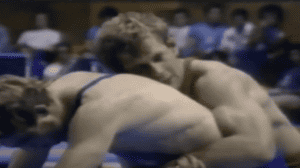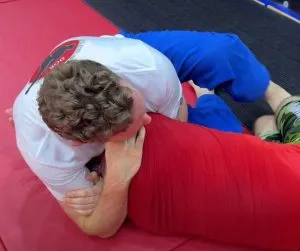Mongolia, a large Asian country that has a deep and rich history, the country of the great Ghengis Khan, his empire stretched as far as Europe and just uttering the word “Mongols” struck terror deep within any country in his path. Being a warrior is in the blood and soul of every Mongolian and warriordom is deeply rooted within all levels of Mongolian society.
A true warrior race, the Mongols perfected warfare and one of their main focuses for hand to hand combat was Bokh and Bokh wrestlers.
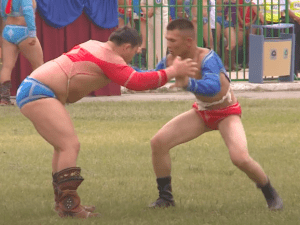
Bokh is the national sport of Mongolia and the name translates as “durability”, a truly perfect name for this cultural wrestling style. There have been depictions of Mongolian wrestlers in cave paintings as far back as 7000 BC and countless amounts of folk tales of mighty wrestlers within each province defeating opponents in valorous manner.
Bokh wrestling was born around 1240 AD and is widely practiced by Mongolians, it is a very developed grappling system with 40 base techniques and 600 variations, adaptations and setups into these techniques also known as “tricks”.
What is Bokh Wrestling
Bokh wrestling is a style of wrestling that is from Mongolia, it is a very old style of wrestling with several sub-styles of Bokh being practiced in Mongolia.
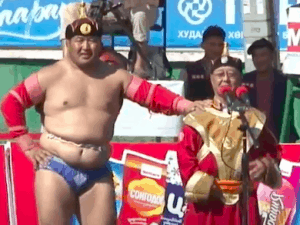
Mongolians cherish Bokh as part of their being and Mongolian wrestlers embody the spiritual and physical ideology of what it is to be a true Mongol for over 2 millennia, this ideology includes the qualities of strength, speed, clear mindfulness, sharpness, patience, respect, peacefulness and love. Wrestling is a symbol of strength, agility and resilience of Mongolia and Bokh wrestlers are highly respected within Mongolian society.
Styles of Bokh Wrestling
There are several sub-styles of Mongolian Bokh wrestling, all are similar but have some significant differences that produce different wrestling attributes. The different styles of Mongolian wrestling are:
Khalkha Bokh, traditional Bokh wrestling practiced by a majority of Mongolian wrestlers, the Khalkha is the largest ethnic group in Mongolia and this style somewhat resembles freestyle wrestling, it is the most popular style and the ruleset is the same as the ruleset within major Bokh tournaments such as the Nadaam festival.
Southern Mongolian Wrestling also known as Khorchin wrestling, this style uses a leather jacket, long pants and specialized boot coverings and has some Bokh techniques and adaptations of techniques that are used more frequently due to the different style uniform worn for this style. This style is said to have influenced Chinese Shuai Jiao wrestling, especially Boke, which is practiced in northern China.
Inner Mongolian wrestling – this style does not allow for grabbing an opponent’s legs or any type of leg attack, wrestlers lose if any part other than their feet touch the ground. Wrestlers are known to have a much more upright stance in inner Mongolian wrestling. Inner Mongolian wrestling is said to be the closest style to that of the Ancient Mongol warriors as most of their combat grappling techniques would need a more upright stance when in a wartime scenario due to the possibility of weapons and the need to move quickly.
Bokh Noololdoon, this style comes from western Mongolia and stretches out into Siberia and China.
Hulunbuir style wrestling – starts matches with no forced contact, no moves are allowed between the legs and hands, Hulunbuir wrestlers are allowed to kick the opponent in the leg and it is not uncommon to see matches last long periods due searching for grips because of no forced contact enforced at the start of the match.
Buryat Wrestling, The Buryat are a ethnic group found in Mongolia and Siberia, this style is somewhat seen in Mongolia along the Russian border but is more associated with the Buryat people of Siberia.
Khuresh – a famous style found in Siberia that has a heavy Bokh influence and this style is somewhat found in all countries that are part of the great central Asian plane. It is a relative of many other wrestling styles that use the same name such as Gures in Turkey, Koras in Tatarstan, Kurash in Uzbekistan, Gores in Turkmenistan, Kuros in Kyrgyzstan, Kures in Kazakhstan and Gules in Azerbaijan. All these countries have taken the word for Khurash from the Old Turkic word – Keris and the style of wrestling is very similar within each country.
Mongolian Bull Wrestling is a style of wrestling where a wrestler needs to get the opponent’s back to touch the ground in order to claim victory.
What are The Rules of Mongolian Wrestling
Bokh wrestling matches do not have a contained or set wrestling area, that is why they are done in open fields and not limited by space or wrestling area borders, this makes for a pure wrestling match where the goal stays simple – to get the opponent off of their feet and onto the ground.
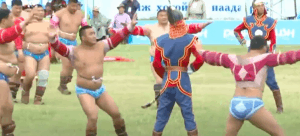
There are no submissions, strangles or joint locks allowed within Bokh wrestling competition.
Each time there is a match, the match will start with both wrestlers performing a traditional Mongolian Bokh dance. Bokh dances generally mimic an animal such as a falcon, hawk, lion, phoenix, tiger and deer as well as can differ from region to region. Once the dance is finished, a wrestler will get into a wide half stance and slap the front of their thighs twice and back of the thighs once in order to declare they are ready to wrestle.
Once a match begins the rules are simple, the purpose is to throw or takedown the opponent to the ground. Generally 2 wrestlers start the match locked together in most regions although some other regions start with the wrestlers not locked together thus forcing some grip fight for positional dominance to occur.
The greater Mongolian wrestling goal is to get the the opponent to either touch his upper body (Torso), knees and elbows on the ground although there are other rules sets that apply to inner Mongolian version rules which are that if any part of the body of the body other than the feet cannot touch the ground, it is an automatic loss.
Bokh matches do not have any weight classes, no age limits and no time limits.
Bokh advocates a very sportsmanlike culture where it is common to see opponents not attacking when an opponent’s clothing gets loose as well as helping a defeated opponent up after a match is very common to see.

Once a match is over, there is also another Bokh dance that signals the end of a match and the defeated wrestler unties his chest belt and slides under the arms of the victor, this represents that the wrestler accepts defeat and his respect to his opponent. Should a lower ranking wrestler beat a higher ranking wrestler the lower ranking wrestler will still untie his chest belt and slide under the arms of the higher ranking wrestler as a sign of respect.
What is the Mongolian Bokh Wrestling Uniform
The Mongolian wrestling uniform has 2 different styles – crescent (tight) and baggy – both of which consists of 4 parts although it is common to see wrestler’s wrestling without the traditional Bokh hat.
The upper body piece is an open chest high quality collarless jacket traditionally made from wool but in modern times is made with cotton and silk strings thread with strings of fiber called a Zodog which is fastened around the chest with a simple string that represents strength and cunning.
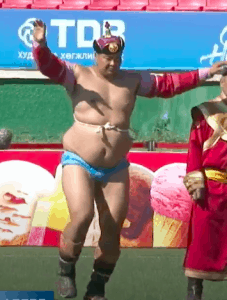
According to legend the reason for the absence of a chest covering is due to the fact that in the past, a woman Bokh wrestler had won a tournament and become champion so to deal with this fact and somewhat prevent women from competing in male tournaments, the chest part of the vest was removed.
Shorts similar to swimmer’s trunks called Shuudag which are made from soft leather strings and strings of fiber and lastly Gutal which are handmade leather boots made by cow leather with a slight upturned toe, it can take half a month to make 2 pairs of boots by hand. Gutal boots can have decorations on them that can be placed after wrestlers earn a rank.
Bokh wrestlers also adorn a hat prior to the match, the hat is 4 sided with each side representing the old 4 provinces of Mongolia, the top knot represents the 5 regions of the Buddhist government. In 1995 a red strip of cloth was added with yellow stripes representing a wrestlers achievements. Finally a silver or golden badge representing rank of falcon, hawk, elephant, phoenix, lion or champion is attached on the front of the hat.
Generally the outfits are worn in red and blue colours due to Mongolians worshipping the land, sky, water and mountains for many generations thus having greatly affected the Bokh uniform colouring.
The Nadaam Bokh Tournament
The largest and most prestigious Bokh tournament is the National Mongolian Bokh tournament at the famous Nadaam festival, Nadaam translates to “Game” and wrestling is one of the 3 Manly sports (Wrestling, Archery and Horsemanship) of the Nadaam festival.
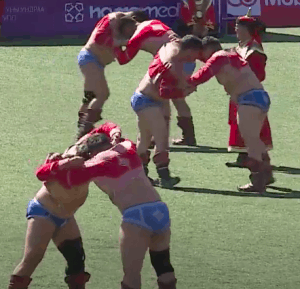
The Nadaam festival is akin to the Olympics of Bokh wrestling and National Mongolian wrestling rank can only be derived from performance in this Nadaam festival where rank is given based upon how many rounds a wrestler has won and moved up on the competition table with the winner of the Nadaam being ranked #1 in the country.
Mongolians believe that a man’s spirit and fortune are lifted when taking part in Nadaam competition and should a wrestler become champion of Nadaam, the rank of champion is held for life.
Nadaam is a very large wrestling tournaments with a staggering 1024 total wrestler’s competing in the tournament. There are 10 total rounds, starting with 1024 wrestlers first round and each round the total number of participants are cut in half with only winners from the previous round continuing to the next round, the 10th and final round has only 2 wrestlers with the winner of that round being declared national champion.
Should a wrestler wins 5 rounds they will receive the rank of Falcon, if they win 6 rounds they receive the rank of Hawk, if they win 7 rounds they receive the rank of Elephant, if 8 rounds they receive the rank of Garuda (Phoenix), if they win 9 rounds they receive the rank of Lion and if they win all 10 rounds they receive rank of Champion.
Regional and Provincial Bokh Competitions
There are many regional Bokh competitions in order to determine regional bokh champions and the ranks are represented by different animals such as the falcon, hawk, elephant, garuda (phoenix) and lion as well as by Champion (as a rank). Wrestler’s get one chance to increase their rank per year, should they lose, they will need to wait an entire year to increase their rank within the region they reside in.
Bokh Wrestling Training
Bokh wrestling training is very effective and challenging with each region having certain training methodologies and specializations that produce great wrestlers.
The most notable Bokh training is when preparing for Nadaam competition, Bokh wrestlers generally take part in a wrestling camp that is situated in nature. The wrestling camp is generally 1 month long with full focus on wrestling preparation and is the absolute best training a Bokh wrestler will take part in.
Training is split where 4 days a week it is more conditioning focused and 3 days a week technical and wrestling sparring focused
Conditioning Focused Bokh Training
Each day starts with an outdoor hike, usually uphill where once the top of the hill is reached they will pay respects to mounds of stones that are placed in honour of Bokh wrestlers. The purpose of this morning hike is to refresh the mind to the day’s hard training sessions that the wrestlers will take part in. The hike also acts as a type of low intensity passive cardio to get the blood flowing in the morning.
Once back from the hike, wrestlers start with dynamic stretching exercises that warm up the body, these exercises are very dynamic with the goal to warm up the entire body and to build and maintain flexibility with strength. Many of the exercises are very focused towards wrestling and preparing for the rigours that a wrestler’s body will go through in the training session.
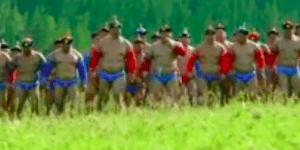
The next part of training is running up and down a large hill (small mountain) several times, this is to build up lactic acid resistance, mental strength and stamina in the legs. Usually this part of training is 15-20 minutes long with the last 40 meters of the last run being a full sprint to finish.
The next part of training is about building up a wrestler’s resilience and overall stamina once again, this part of training consists of plyometric line drills, with different footwork patterns, leg strengthening exercises, jumping patterns and explosive squat line drills. Once again all these drills focus on wrestling movements and are very specific to Bokh wrestling.
The next part of training has wrestlers performing carrying drills where they carry their training partners for distance, in certain cases when near a shallow river, they will carry their training partner across the river and back. These specific bodyweight carry drills are done several times each. They build stamina and functional wrestling strength. Carrying training partners across a river is rather difficult as the bottom of the river is slippery and full of stones, this causes specific small muscles in the ankles, calves and feet to become stronger.
Next part of conditioning training is strength training. Wrestlers perform a large amount of pushups, situps, and crunches. All exercises are done with the coach counting and should someone perform a half rep, the count restarts from zero again.
It is very common to see wrestlers doing pull ups and other strength training exercises after the training as they are very focused on coming into competition at their peak level of fitness. Mongolian wrestlers are known to be some of the strongest wrestlers on the planet and it is for good reason, they train hard and train intelligently.
Technique Focused Bokh Training
3 days a week are focused towards technical training and preparing the wrestlers for Nadaam. Nadaam is a large tournament and with so many Bokh competitors, wrestlers must make sure they are fully proficient in all of the Bokh techniques and tricks should they want to become champion.

The day begins with wrestlers putting on the traditional wrestling uniform and thus training begins with a light jog that has the wrestlers raising their arms up like falcon (warming up the shoulders) and performing a dance which resembles a falcon or hawk, afterwards going into a wide stanced half squat position and slap the front of their thighs once, the back of their thighs once and the front of their thighs again as a gesture towards their opponent to challenge them and notify that they are ready for battle.
The training continues with some light sparring where the wrestlers try to perform their favorite training techniques many times over and try out new techniques they have learned. They will go over small details in their techniques in order to fix mistakes and gain better technical proficiency.
It is important to note that Monglian wrestling training camps are taken very seriously by the athletes and coaches who partake in them and there are certain rules when in a training camp such as wrestlers cannot drink alcohol, they may not leave the training camp/grounds without permission and they must follow advice and instructions as if it is law.
Bokh Influence on Judo, Sumo and Olympic Wrestling
Mongolia has one of the best Judo teams in the world, having produced many world and Olympic champions as well as having a very powerful and unorthodox Judo style. The success that Mongolians have found within Judo can directly be accredited to the influence that Bokh had on Mongolia’s Judo program. Mongolian Judo is one of the most influential Judo styles in the world.
Bokh has also had a direct influence on Mongolian freestyle and greco wrestling as it is not uncommon to see Mongolian wrestlers use Bokh techniques within international wrestling competition.
Unbeknown to most of the world, there have been many Mongolians who have become Sumo champions and have used Bokh techniques to dominate in Sumo competition, many times beating the Japanese Sumo wrestlers at their own game.
Mongolian Bokh in MMA
There have been some Mongolian MMA fighters who have found success within the cage, many of them using some Bokh techniques to dominate the opponent. The future looks bright in regards to Bokh being used more and more within MMA competition.
The biggest factor slowing Bokh being showcased within MMA is the lack of funding in the Mongolian MMA scene in order to build Mongolian fighters into world class MMA talent. Mongolians have all the characteristics to dominate in MMA, they are intelligent, strong, resilient, mentally strong and talented fighters.
With some proper funding into Mongolian MMA, we are certain to see Bokh being used in the cage in a dominant manner just as it has been used on the battlefield for centuries.
In Conclusion
Mongolian wrestling is about resilience and respect with wrestlers giving the utmost respect to higher ranking and older wrestlers.
Bokh is a medium for giving mutual respect for one another. This has been passed from generation to generation which has greatly developed Mongolian men physically, spiritually and mentally over centuries. Bokh is not only a wrestling style it is the heartbeat of the Mongolian people.


